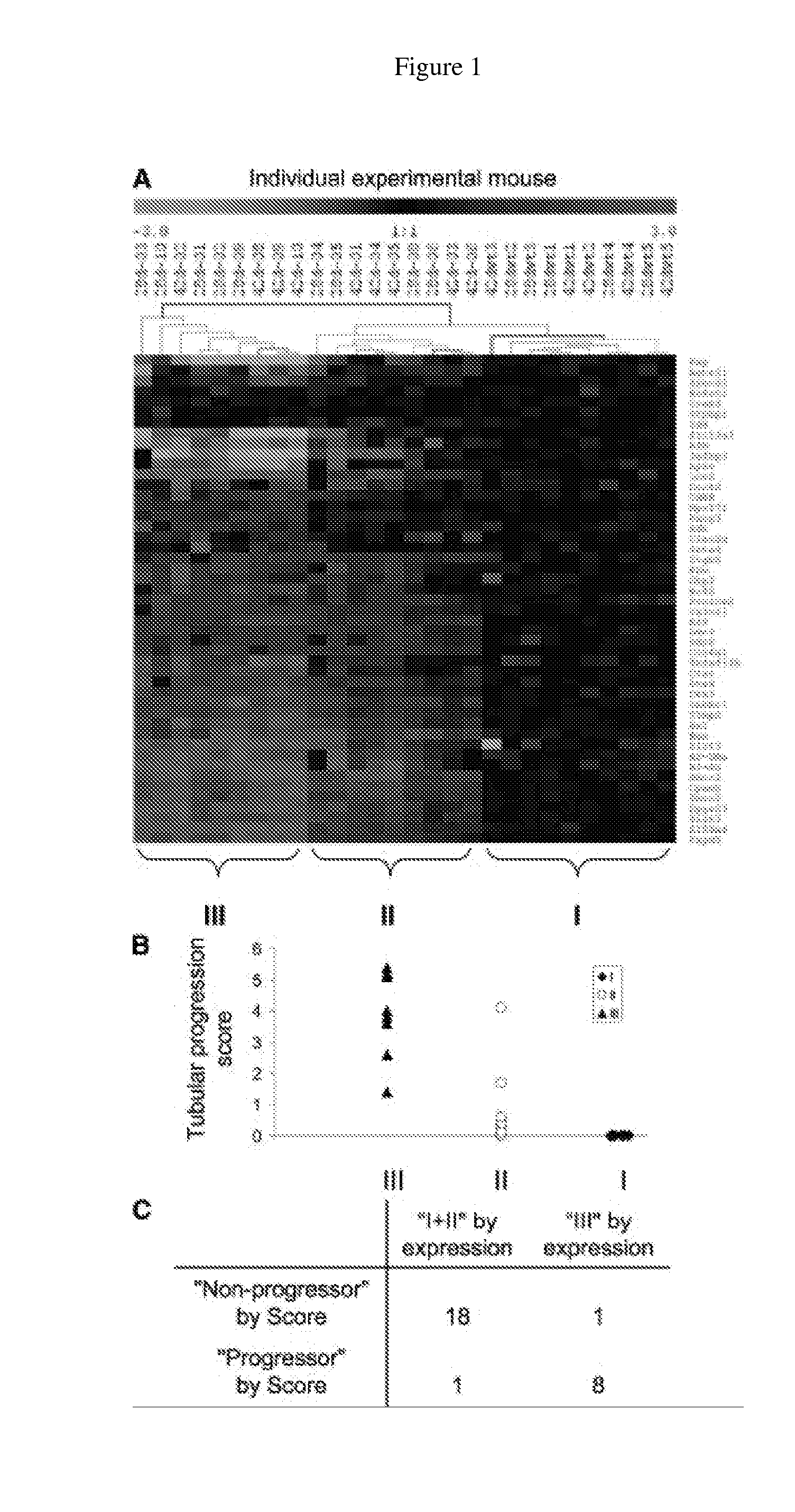Methods for diagnosing chronic kidney disease and assessing the risk of disease progression
a technology for chronic kidney disease and risk assessment, applied in the field of chronic kidney disease diagnosis and risk assessment, can solve the problems of severely limited the application of genomic profiling in nonmalignant kidney diseases, and insufficient accuracy of clinical markers to reliably predict the etc., to facilitate the diagnosis of the effect of diagnosing a risk of ckd progression
- Summary
- Abstract
- Description
- Claims
- Application Information
AI Technical Summary
Benefits of technology
Problems solved by technology
Method used
Image
Examples
example 1
Materials and Methods
[0059]The following materials and methods were used in the experiments described in Examples 2-6.
[0060]Mouse Models
[0061]Albumin / Tgfb1 Tg mice (Kopp, et al., Lab Invest. 1996, 74:991-1003) in a C57BL / 6J X CBA background were maintained at the Animal Resource Center of Mount Sinai School of Medicine. Experiments were performed according to an approved protocol of the institutional animal care and use committee.
[0062]Kidney Total RNA Isolation
[0063]Harvested mouse kidneys were homogenized in Trizol reagent (Invitrogen, Carlsbad, Calif.) for 40 seconds using PowerGen125 (Fisher Scientific, Pittsburgh, Pa.) at maximum speed. Total RNA was isolated according to the manufacturer's protocol. Quality and quantity of total RNA was checked by Bio-analyzer (Agilent, Santa Clara, Calif.).
[0064]Histological Analysis
[0065]Harvested kidneys were embedded in paraffin after fixing in 10% formalin overnight and then sectioned at 4-μm thickness. Periodic acid-Schiff (PAS)-stained ...
example 2
Identification of a Gene Expression Signature of Advanced Glomerular Apoptosis Activity in Kidneys of Tgfb1 Tg Mice
[0092]Kidneys from 2-week-old Tg mice were characterized by severe podocyte apoptosis and mild mesangial expansion in some, but not all, animals, while the tubulointerstitial compartment was normal (Schiffer, et al., J. Clin. Invest. 2001, 108:807-816). To identify gene expression patterns that are associated with quantitative measures of apoptosis, extracellular matrix accumulation, or inflammatory cell infiltrates at the early stage of progressive renal disease in this model, respectively, microarray and detailed quantitative phenotype analyses in wild-type and Tgfb1 Tg mice were performed. Matrix accumulation and tubulointerstitial inflammation were assessed by quantitative digital analysis of α-1-collagen 1 and Mac3 immunohistochemistry, respectively. Glomerular and tubulointerstitial cell apoptosis rates were quantitated by TUNEL assay. With the exception of glomer...
example 3
Validation of 43-Gene Expression Signature to Classify Tubulointerstitial Disease Heterogeneity in Older Tgfb1 Tg Mice
[0094]By 4 or 6 weeks of age, histopathological manifestations of progressive renal disease, including tubular atrophy and interstitial inflammation, were established and highly variable in Tgfb1 Tg mice. Next, the question of whether the expression patterns of the 43-geneset (i.e., set of 43 genes described in Example 2) in 4- and 6-week-old mice are suitable for classifying the mice by progression of histopathological manifestations in the kidney was addressed. An interrelated two-way (that is, genes against mice) hierarchical clustering method was implemented using an unsupervised approach. The goal of clustering is to find important gene expression patterns and perform cluster discovery on experimental mice. The advantage of this approach is that the relationships between the groups of genes and mice can be used dynamically while iteratively clustering through bo...
PUM
| Property | Measurement | Unit |
|---|---|---|
| Temperature | aaaaa | aaaaa |
| Temperature | aaaaa | aaaaa |
| Fraction | aaaaa | aaaaa |
Abstract
Description
Claims
Application Information
 Login to View More
Login to View More - R&D
- Intellectual Property
- Life Sciences
- Materials
- Tech Scout
- Unparalleled Data Quality
- Higher Quality Content
- 60% Fewer Hallucinations
Browse by: Latest US Patents, China's latest patents, Technical Efficacy Thesaurus, Application Domain, Technology Topic, Popular Technical Reports.
© 2025 PatSnap. All rights reserved.Legal|Privacy policy|Modern Slavery Act Transparency Statement|Sitemap|About US| Contact US: help@patsnap.com



